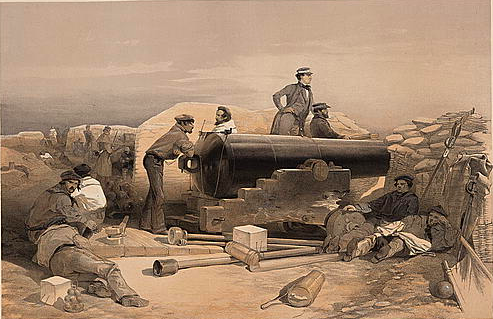by Jim Garrison

Richard C. McCormick was one of the first modern war correspondents, and one of many outsiders who came to observe the struggle in Crimea. His journey to Crimea came after the popularity of William Howard Russell who had gained fame for his reporting on the horrible conditions of the British soldiers. While in Crimea McCormick reported on more of the same awful conditions. McCormick’s arrival at Balaklava on December 1st, 1854 marked the beginning of his 6-week stay.
After sailing from Constantinople along with excited British and French soldiers, he landed in Balaklava harbour. The first thing he noticed was the toll the war had taken on the soldiers already there. He described the horses as looking like “Breathing skeletons,” the men as “jaded and worn,” and their uniforms looking “as though it had been through all the wars of the last dozen centuries.”[1] Many of the soldiers in Balaklava were in such bad condition that the ship he arrived on had to change plans and carry these men back to Constantinople for medical help. Scenes of sick and injured soldiers were commonplace throughout his wartime travels.
The first chapter of Tolstoy’s Sevastopol Sketches, “December 1854,” takes place during the same month that McCormick arrived at Balaklava. Tolstoy’s depiction of Sevastopol shows the horrible conditions Russian soldiers had to live through. Rotting corpses of horses littered the streets and amputees at the military hospital had to lay on the floor because they had run out of beds. McCormick never got to see the state of Sevastopol in person; all his information on the city came from interviewing generals. McCormick’s description of the state of Sevastopol never went beyond its strategic positions. The conditions Tolstoy described are not too different from the sights that McCormick reported on during his visit to Balaklava and Constantinople.
McCormick began traveling to the numerous trenches and camps in Crimea. He took note of the daily routines of the soldiers and the weather of the area. Comparing the conditions of the British and French soldiers he noted that the British were “overworked, poorly fed, and suffering from a complication of maladies.” He described the French by comparison, as “well-provisioned, well-clad, and comparatively free from sickness.”[2] In an article written February 9, 1855, for the New York Evening Post the unnamed author believed to be McCormick described the conditions of the British troops who had suffered severe losses under Lord Raglan. They suffered losses of well over 43,000 while the French continued to grow numbers.[3] Allied ships constantly patrolled the coast, and he noticed that many British-owned transport ships outside of Balaklava were of American make and model.[4] McCormick also witnessed multiple cases of negligence with regards to critical supplies, writing that “quantities of much-needed goods and provisions were wasting in storehouses because no one would authorize their distribution.”[5] McCormick even recognized the work of William Russell in uncovering the misuse of supplies and the poor conditions of the soldiers.
McCormick made many acquaintances throughout his journey in Crimea. Mr. Upton was the son of Colonel Upton who owned a farm just outside of Sevastopol. Colonel Upton was taken as a prisoner of war by Allied forces and moved into an apartment in Balaklava. His farm was pillaged by allied foraging parties. McCormick obtained much information about the surrounding area, population, and climate from the Uptons.[6] He also became well acquainted with several British and French officials. Lieutenant Macgregor, leader of the 97th regiment, spoke with McCormick often and on one occasion accompanied him on an examination of Inkerman field where heavy fighting had just recently taken place. The American journalist frequently dined with officers, learning of the current state of affairs. More often than not these conversations turned to the subject of the horrible conditions the soldiers faced and the lack of supplies that plagued them.[7]
After spending six weeks in Balaklava McCormick returned to Constantinople. While on the ship he witnessed sick and dying soldiers, many of whom ended up being buried at sea. Upon reaching Constantinople McCormick investigated a French hospital in Pera which despite being a “comfortable retreat” for the sick and injured, held a massive pile of military equipment left behind by soldiers who had passed on.[8] While he visited an undersupplied English hospital in Scutari, he briefly caught a glimpse of Ms. Florence Nightingale. Before her arrival Scutari hospitals had been known for the awful treatment of the sick and injured, even leaving patients to huddle on the floor after running out of beds.[9]
Richard Cunningham McCormick through his reporting gave U.S. citizens an honest look at the events happening in Crimea without shying away from the grotesque reality of war. His travels around Crimea and Constantinople provided readers of the Evening Post a broad view of the state of the war. The experience he gained from reporting on the battlefield in Crimea would go on to serve him well when the Civil War broke out in the United States.
Notes
[1] Richard Cunningham McCormick, A Visit to the Camp before Sevastopol (New York: D. Appleton and Co., 1855), 28
[2] McCormick A Visit to the Camp before Sevastopol Pg 101
[3] “Condition of the British Troops in the Crimea” New York Evening Post, March 15,1855 http://nyshistoricnewspapers.org/lccn/sn83030390/1855-03-15/ed-1/seq-1/
[4] McCormick A Visit to the Camp before Sevastopol Pg 68, 95, 127
[5] McCormick A Visit to the Camp before Sevastopol Pg 155, 156
[6] McCormick A Visit to the Camp before Sevastopol Pg 70, 71
[7] McCormick A Visit to the Camp before Sevastopol Pg 156, 157
[8] McCormick A Visit to the Camp before Sevastopol Pg 168 – 170
[9] McCormick A Visit to the Camp before Sevastopol Pg 180-19